#araneiform
Explore tagged Tumblr posts
Text
youtube
Fucking nuts and important to me AT LEAST.
#TigerBeat6#ddamage#ink808#kid606#knifehandchop#improvindustrial#2000sAnimation#raremusicvideo#araneiform#Youtube
6 notes
·
View notes
Text
Tests on Earth appear to confirm how the red planet's spider-shaped geologic formations are carved by carbon dioxide. Since discovering them in 2003 via images from orbiters, scientists have marveled at spider-like shapes sprawled across the southern hemisphere of Mars. No one is entirely sure how these geologic features are created. Each branched formation can stretch more than a half-mile (1 kilometer) from end to end and include hundreds of spindly "legs." Called araneiform terrain, these features are often found in clusters, giving the surface a wrinkled appearance.
Continue Reading.
#Science#Space#Astronomy#Planetary Science#Mars#Araneiform Terrain#NASA#National Aeronautics and Space Administration
73 notes
·
View notes
Text

The Enduring Charm of Martian Spiders
Araneiform terrain (colloquially: spider-like terrain) is located in the south polar region of Mars and evolves in appearance over the spring and summer. In the season shown here, the thin bright lines on the surface (the spider legs) are troughs and many of these features have dark fan-shaped markings emanating from them.
One idea for how these patterns are formed is that during winter a carbon dioxide ice layer develops over the surface. When sun rays strike this surface, this carbon dioxide ice acts in a similar way to our atmosphere: it allows the sun light to penetrate but traps the infrared radiation creating a greenhouse-like effect.
The trapped heat transforms the ice at the bottom of the layer to gas, building up pressure until it bursts through. When that happens, the gas flows out in geyser-like fashion and carries dust with it, which falls back to the surface to form the dark fans.
ID: ESP_056927_0940 date: 18 September 2018 altitude: 246 km
NASA/JPL-Caltech/University of Arizona
48 notes
·
View notes
Text
ARTICLES AND BOOKS (and illustrations!) BY H. GOODSIR
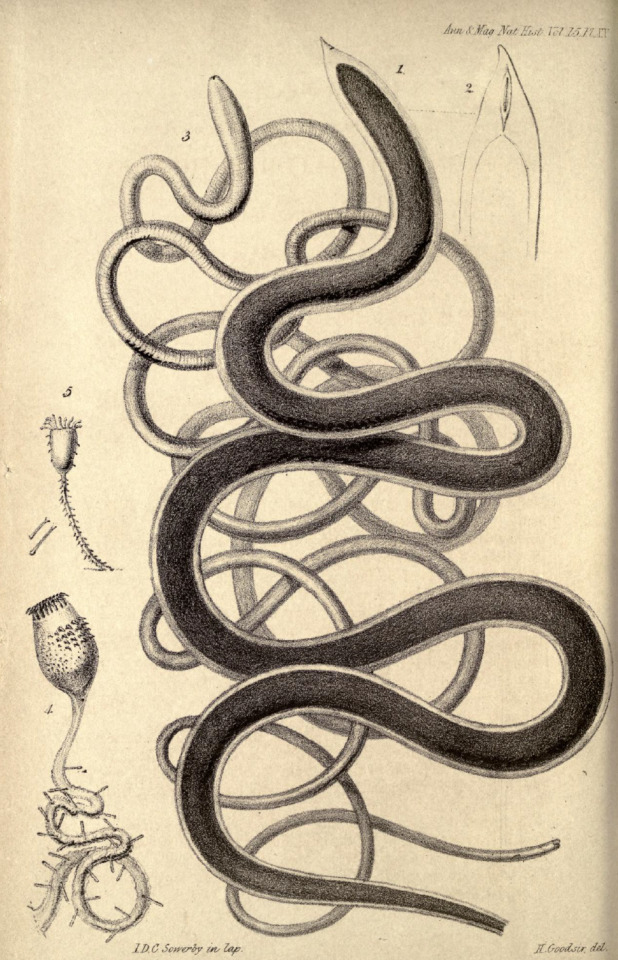
BOOKS
- Anatomical and pathological observations, 1845.
Goodsir, John (1814-1867) Goodsir, Henry Duncan Spens ("Harry") (1819-1847).
Link: https://www.biodiversitylibrary.org/item/75603#page/9/mode/1up
Harry is the author of the following three chapters:
N°VI. The testis and its secretion in the decapodous crustaceans (pp 35-40)
N°XII. The mode of reproduction of the lost parts in the crustacea (pp 74-78)
N°XIII. Of the anatomy and development of the cystic entozoa (pp 79-103)
> The last one was read before the York Meeting of the British Association in 1844. I did a little research and found that Goodsir was “secretary” in the zoology and botany section:
(Read more:https://www.ypsyork.org/resources/articles/the-1844-british-association-conference-and-the-first-photographs-taken-in-york/ )
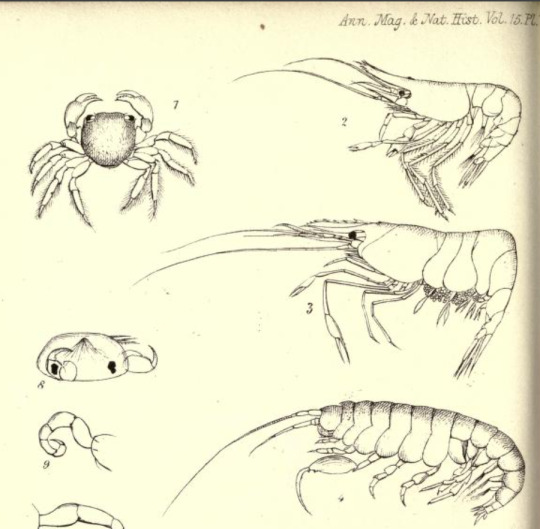
-Cases and observations illustrating the history and pathological relations of two kinds of hydatids, hitherto undescribed, 1844
Goodsir, Harry D. S. , Gairdner, John, Lee Thomas M. , Royal College of Physicians of Edinburgh
Link: https://www.biodiversitylibrary.org/item/180385#page/3/mode/1up
Microscopial observations (two pages of illustrations at the end of the book, low quality).

-On two new species of leachia, 1841
Goodsir, Henry D. S. Esq.
(from the Edimburgh New philosophical Journal for October 1841)
Link: https://www.biodiversitylibrary.org/item/188531#page/1/mode/1up
(One illustration at the end)
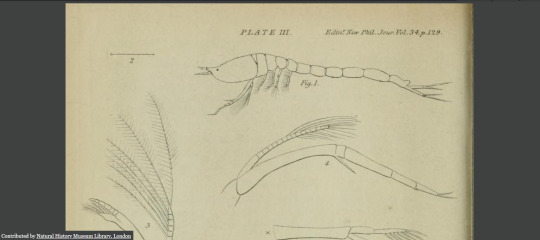
ARTICLES
-Description of the genus Cuma, and of two new genera nearly allied to it, 1843
in: The Edinburgh new philosophical journal, vol. 34, pp 119-129
Link: https://www.biodiversitylibrary.org/page/12565428#page/139/mode/1up
(Illustrations at the end)
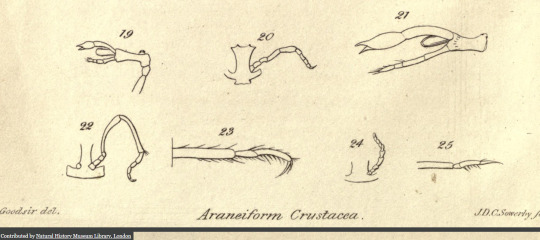
-On the specific and generic characters of the araneiform crustacea, 1844
in: The Annals and magazine of natural history; zoology, botany and geology, vol. 14, pp 1-4
Link: https://www.biodiversitylibrary.org/page/2331360#page/14/mode/1up
(One plate at the beginning)
- Description of some animals found amongst the Gulf-weed, february 1845
in: The Annals and magazine of natural history; zoology, botany and geology, vol. 15, pp 73-76
Link: https://www.biodiversitylibrary.org/page/2248314#page/98/mode/1up
(One plate at the beginning)
- Description of some gigantic forms of invertebrate animals from the coast of Scotland, june 1845
in: The Annals and magazine of natural history; zoology, botany and geology, vol. 15, pp 377-383
Link: https://www.biodiversitylibrary.org/page/2248663#page/427/mode/1up
(One plate at the beginning)

-On the development, structure and eoconomy of the acephalocysts of authors; with an account of the natural analogies of the entozoa in general, june 1845
in: The Annals and magazine of natural history; zoology, botany and geology, vol. 14, pp 481-484
Link: https://www.biodiversitylibrary.org/page/22068990#page/495/mode/1up
Abstracted from the Transactions of the Royal Society of Edinburgh, having been read April 1, 1844.
> which I, of course, found:
Transactions of the Royal Society of Edinburgh, vol XV
pp. 560-571, three plates
Link: https://archive.org/details/transactionsofro15roya/page/560/mode/2up?view=theater
(His brother was also there!)

-On several new species of Crustaceans allied to Saphirina, 1845
in: The Annals and magazine of natural history; zoology, botany and geology, vol. 16, pp 325-327
Link: https://www.biodiversitylibrary.org/page/22069398#page/339/mode/1up
+Plate XI (at the end)
This last article is also mentionning the Erebus... I'm not crying, you are.
PS: I hope you enjoyed this overview of Goodsir's work, it took me days to gather it all and I'm glad to be able to share it with you all. As I'll soon be in Edinburgh, you can expect to see more Goodsir content! Love <3
100 notes
·
View notes
Text




NASA scientists recreate Mars's spider-shaped geologic formations in lab for the first time
Tests on Earth appear to confirm how the red planet's spider-shaped geologic formations are carved by carbon dioxide.
Since discovering them in 2003 via images from orbiters, scientists have marveled at spider-like shapes sprawled across the southern hemisphere of Mars. No one is entirely sure how these geologic features are created. Each branched formation can stretch more than a half-mile (1 kilometer) from end to end and include hundreds of spindly "legs." Called araneiform terrain, these features are often found in clusters, giving the surface a wrinkled appearance.
The leading theory is that the spiders are created by processes involving carbon dioxide ice, which doesn't occur naturally on Earth. Thanks to experiments detailed in a new paper published in The Planetary Science Journal, scientists have, for the first time, re-created those formation processes in simulated Martian temperatures and air pressure.
"The spiders are strange, beautiful geologic features in their own right," said Lauren Mc Keown of NASA's Jet Propulsion Laboratory in Southern California. "These experiments will help tune our models for how they form."
The study confirms several formation processes described by what's called the Kieffer model: Sunlight heats the soil when it shines through transparent slabs of carbon dioxide ice that built up on the Martian surface each winter.
Being darker than the ice above it, the soil absorbs the heat and causes the ice closest to it to turn directly into carbon dioxide gas—without turning to liquid first—in a process called sublimation (the same process that sends clouds of "smoke" billowing up from dry ice). As the gas builds in pressure, the Martian ice cracks, allowing the gas to escape. As it seeps upward, the gas takes with it a stream of dark dust and sand from the soil that lands on the surface of the ice.
When winter turns to spring and the remaining ice sublimates, according to the theory, the spiderlike scars from those small eruptions are what's left behind.
Recreating Mars in the lab
For Mc Keown and her co-authors, the hardest part of conducting these experiments was re-creating conditions found on the Martian polar surface: extremely low air pressure and temperatures as low as minus 301 degrees Fahrenheit (minus 185 degrees Celsius). To do that, Mc Keown used a liquid-nitrogen-cooled test chamber at JPL, the Dirty Under-vacuum Simulation Testbed for Icy Environments, or DUSTIE.
"I love DUSTIE. It's historic," Mc Keown said, noting that the wine barrel-size chamber was used to test a prototype of a rasping tool designed for NASA's Mars Phoenix lander. The tool was used to break water ice, which the spacecraft scooped up and analyzed near the planet's north pole.
For this experiment, the researchers chilled Martian soil simulant in a container submerged within a liquid nitrogen bath. They placed it in the DUSTIE chamber, where the air pressure was reduced to be similar to that of Mars's southern hemisphere. Carbon dioxide gas then flowed into the chamber and condensed from gas to ice over the course of three to five hours. It took many tries before Mc Keown found just the right conditions for the ice to become thick and translucent enough for the experiments to work.
Once they got ice with the right properties, they placed a heater inside the chamber below the simulant to warm it up and crack the ice. Mc Keown was ecstatic when she finally saw a plume of carbon dioxide gas erupting from within the powdery simulant.
"It was late on a Friday evening and the lab manager burst in after hearing me shrieking," said Mc Keown, who had been working to make a plume like this for five years. "She thought there had been an accident."
The dark plumes opened holes in the simulant as they streamed out, spewing simulant for as long as 10 minutes before all the pressurized gas was expelled.
The experiments included a surprise that wasn't reflected in the Kieffer model: Ice formed between the grains of the simulant, then cracked it open. This alternative process might explain why spiders have a more "cracked" appearance. Whether this happens or not seems dependent on the size of soil grains and how embedded water ice is underground.
"It's one of those details that show that nature is a little messier than the textbook image," said Serina Diniega of JPL, a co-author of the paper.
What's next for plume testing
Now that the conditions have been found for plumes to form, the next step is to try the same experiments with simulated sunlight from above, rather than using a heater below. That could help scientists narrow down the range of conditions under which the plumes and ejection of soil might occur.
There are still many questions about the spiders that can't be answered in a lab. Why have they formed in some places on Mars but not others? Since they appear to result from seasonal changes that are still occurring, why don't they seem to be growing in number or size over time? It's possible that they're left over from long ago, when the climate was different on Mars—and could therefore provide a unique window into the planet's past.
For the time being, lab experiments will be as close to the spiders as scientists can get. Both the Curiosity and Perseverance rovers are exploring the red planet far from the southern hemisphere, which is where these formations appear (and where no spacecraft has ever landed). The Phoenix mission, which landed in the northern hemisphere, lasted only a few months before succumbing to the intense polar cold and limited sunlight.
TOP IMAGE: Spider-shaped features called araneiform terrain are found in the southern hemisphere of Mars, carved into the landscape by carbon dioxide gas. This 2009 image taken by NASA’s Mars Reconnaissance Orbiter shows several of these distinctive formations within an area three-quarters of a mile (1.2 kilometers) wide. Credit: NASA / JPL-Caltech / University of Arizona
CENTRE IMAGE: These formations similar to the Red Planet’s “spiders” appeared within Martian soil simulant during experiments in JPL’s DUSTIE chamber. Carbon dioxide ice frozen within the simulant was warmed by a heater below, turning it back into gas that eventually cracked through the frozen top layer and formed a plume. Credit: NASA / JPL-Caltech
LOWER IMAGE: Dark splotches seen in this example of araneiform terrain captured by NASA’s Mars Reconnaissance Orbiter in 2018 are believed to be soil ejected from the surface by carbon dioxide gas plumes. A set of experiments at JPL has sought to re-create these spider-like formations in a lab. Credit: NASA / JPL-Caltech / University of Arizona
BOTTOM IMAGE: Here’s a look inside of JPL’s DUSTIE, a wine barrel-size chamber used to simulate the temperatures and air pressure of other planets – in this case, the carbon dioxide ice found on Mars’ south pole. Experiments conducted in the chamber confirmed how Martian formations known as “spiders” are created. Credit: NASA / JPL-Caltech
2 notes
·
View notes
Link
Spiders on Mars are part of a geological feature called araneiform terrain, formed by carbon dioxide eruptions, resembling spiders scurrying when viewed from a height., Archaeologists in Egypt discovered a 3,200-year-old military barracks containing a bronze sword inscribed with hieroglyphs mentioning Ramesses II, likely belonging to a high-ranking officer., The 3,200-year-old sword found in Egypt was intended for fighting, not just display, as it was located in a less-protected area of the barracks for defense against enemies., Fossilized jaw fragments of a 80-million-year-old sea monster discovered in Texas display blunt teeth for crushing prey, showing the brute force they brought to bear on their victims., Cities like Milan, Jakarta, and San Diego are adapting to climate change challenges in different ways, focusing on issues like flooding, water scarcity, and rising sea levels, offering a hopeful vision for climate adaptation globally.
0 notes
Text
Las misteriosas 'Arañas' de Marte reproducidas en la Tierra

Un avance reciente ha permitido replicar las peculiares formaciones geológicas con forma de araña que se encuentran en la superficie del hemisferio sur de Marte. Estas estructuras, conocidas como 'arañas marcianas' o terrenos araneiformes, han sido objeto de fascinación desde su descubrimiento en 2003. Ahora, un nuevo estudio publicado en The Planetary Science Journal ha descifrado parte del misterio al lograr reproducirlas en la Tierra bajo condiciones controladas de laboratorio, abriendo una nueva ventana al conocimiento de los procesos geológicos marcianos. ¿Qué son las 'arañas' de Marte? Las 'arañas' de Marte son formaciones geológicas con ramificaciones que se extienden desde un punto central, asemejándose a la apariencia de los arácnidos. Estas estructuras pueden alcanzar hasta un kilómetro de ancho y están principalmente agrupadas en áreas del hemisferio sur del planeta. Lo que hace a estas formaciones aún más intrigantes es su aparición exclusivamente en Marte, lo que ha dejado perplejos a los científicos durante décadas. Los terrenos araneiformes presentan un aspecto "arrugado" en la superficie marciana, lo que ha llevado a múltiples hipótesis sobre su origen. Los científicos inicialmente sugirieron que estas estructuras podrían formarse debido a la sublimación del hielo de dióxido de carbono (CO2), un proceso que ocurre cuando el hielo pasa directamente del estado sólido al gaseoso sin convertirse en líquido.

Un experimento en la Tierra para recrear las arañas marcianas El equipo de investigación, compuesto por expertos internacionales, buscó probar la hipótesis de la sublimación del hielo de CO2 en un entorno controlado. Para ello, utilizaron un dispositivo especializado denominado DUSTIE (Dynamical Ultra-Low Temperature Simulated Environment), capaz de replicar las bajas temperaturas y la baja presión atmosférica características de Marte. Este dispositivo permitió a los científicos recrear el proceso de sublimación que ocurre en la superficie marciana durante el cambio estacional de invierno a primavera. Al generar hielo de CO2 en las mismas condiciones que en Marte y luego exponerlo a la luz del Sol simulado, el equipo observó cómo este hielo sublimaba, liberando gases que agrietaban la superficie simulada. Este proceso recreó con éxito la formación de estructuras similares a las 'arañas' de Marte. ¿Cómo se forman estas estructuras en Marte? El proceso que da lugar a las arañas marcianas comienza durante el invierno, cuando el CO2 se congela y forma capas de hielo sobre la superficie del planeta. Con la llegada de la primavera marciana, la radiación solar calienta estas capas de hielo, transformando el CO2 sólido en gas. Este gas queda atrapado bajo la superficie, lo que aumenta la presión y finalmente provoca la ruptura del suelo marciano. A medida que el gas escapa, arrastra consigo polvo oscuro y arena, creando los patrones ramificados que se asemejan a las patas de una araña. Este fenómeno es exclusivo de Marte debido a su atmósfera delgada y las extremas variaciones de temperatura. Resultados del experimento El experimento en el laboratorio fue un éxito al confirmar que la sublimación del hielo de CO2 es el mecanismo responsable de las arañas marcianas. Al calentar el hielo dentro del DUSTIE, los científicos observaron la aparición de columnas de gas que, al escapar del suelo simulado, provocaron la formación de grietas y cavidades similares a las observadas en Marte. Esta investigación marca la primera vez que se ha logrado replicar este proceso en la Tierra, brindando un apoyo crucial a la teoría de la sublimación del CO2 como origen de las arañas marcianas. Sin embargo, aún queda mucho por investigar. Los científicos planean continuar realizando experimentos similares para entender por qué estas formaciones se encuentran en áreas específicas del hemisferio sur de Marte y por qué no parecen cambiar de tamaño con el tiempo. Implicaciones futuras Este estudio representa un importante avance en nuestra comprensión de los procesos geológicos de Marte. Reproducir fenómenos marcianos en la Tierra es clave para prepararse para futuras misiones de exploración y, eventualmente, la colonización del planeta rojo. Comprender cómo se forman y evolucionan las arañas marcianas podría aportar información valiosa sobre la dinámica de la atmósfera marciana, las estaciones y los cambios climáticos en el planeta. Además, estos experimentos no solo permiten entender mejor Marte, sino que también nos brindan pistas sobre cómo el dióxido de carbono y otros gases interactúan con el suelo en condiciones extremas, lo que puede tener aplicaciones en la geología de otros cuerpos celestes e incluso en estudios sobre la Tierra misma. La recreación de las misteriosas 'arañas' de Marte en un laboratorio terrestre ha sido un gran logro científico que nos acerca un paso más a entender los complejos procesos geológicos de nuestro vecino planetario. A medida que se realicen más experimentos, es probable que sigamos descubriendo más detalles sobre estas estructuras y lo que nos pueden revelar sobre la historia y el clima de Marte. Ecoportal.net Con información de: https://actualidad.rt.com/ Read the full article
0 notes
Text
Quando i “Ragni” di Marte si risvegliano
Durante l’inverno al Polo Sud di Marte, una calotta di ghiaccio di anidride carbonica ricopre la regione e, al ritorno del sole in primavera, i “ragni” iniziano a emergere dal paesaggio. Ma non si tratta di ragni veri e propri. Lo chiamano “terreno araneiforme”, per descrivere i canali radianti simili a ragni che si formano quando il ghiaccio di anidride carbonica sotto la superficie si riscalda…

View On WordPress
0 notes
Text
There's a phenomenon called Martian Areneiforms and they made me think of neuron cells and I did a draw of them ☺️

0 notes
Text

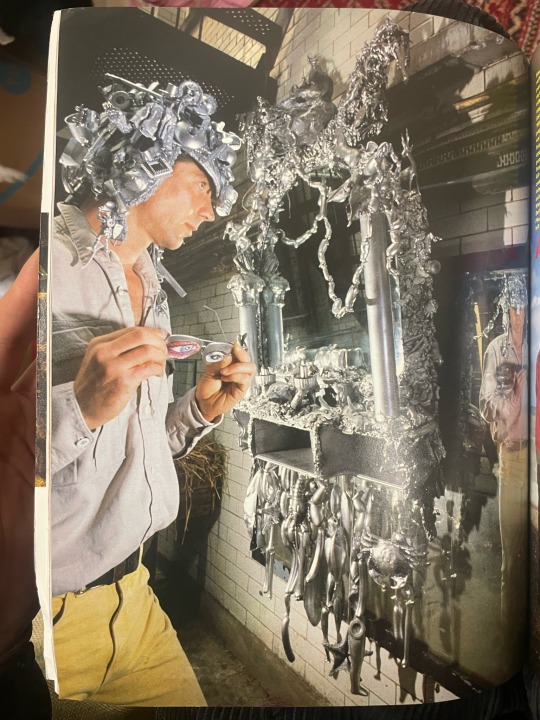
Somebody collected lots of sticks to make a big stick tree and lots of silver things for a big chrome life form reflektor!
I used to have a shelf full of my collections. Bottlecaps, spoons, and feathers. Id find them in the street, I never spent money on them.
0 notes
Photo

From NASA Image of the Day; July 13, 2018:
Jamming with the 'Spiders' from Mars
This image from NASA's Mars Reconnaissance Orbiter, acquired May 13, 2018 during winter at the South Pole of Mars, shows a carbon dioxide ice cap covering the region and as the sun returns in the spring, "spiders" begin to emerge from the landscape.
But these aren't actual spiders. Called "araneiform terrain," describes the spider-like radiating mounds that form when carbon dioxide ice below the surface heats up and releases. This is an active seasonal process not seen on Earth. Like dry ice on Earth, the carbon dioxide ice on Mars sublimates as it warms (changes from solid to gas) and the gas becomes trapped below the surface.
Over time the trapped carbon dioxide gas builds in pressure and is eventually strong enough to break through the ice as a jet that erupts dust. The gas is released into the atmosphere and darker dust may be deposited around the vent or transported by winds to produce streaks. The loss of the sublimated carbon dioxide leaves behind these spider-like features etched into the surface.
The University of Arizona, Tucson, operates HiRISE, which was built by Ball Aerospace & Technologies Corp., Boulder, Colorado. NASA's Jet Propulsion Laboratory, a division of Caltech in Pasadena, California, manages the Mars Reconnaissance Orbiter Project for NASA's Science Mission Directorate, Washington.
Image download options
#nasa image of the day#long post#astronomy#geology#satellite photo#mars reconnaissance orbiter#geyser#sublimation#spiders#araneiform terrain#carbon dioxide#Mars
2 notes
·
View notes
Text
Jamming with the 'Spiders' from Mars
NASA - Mars Reconnaissance Orbiter (MRO) logo. July 13, 2018
This image from NASA's Mars Reconnaissance Orbiter, acquired May 13, 2018 during winter at the South Pole of Mars, shows a carbon dioxide ice cap covering the region and as the sun returns in the spring, "spiders" begin to emerge from the landscape. But these aren't actual spiders. Called "araneiform terrain," describes the spider-like radiating mounds that form when carbon dioxide ice below the surface heats up and releases. This is an active seasonal process not seen on Earth. Like dry ice on Earth, the carbon dioxide ice on Mars sublimates as it warms (changes from solid to gas) and the gas becomes trapped below the surface. Over time the trapped carbon dioxide gas builds in pressure and is eventually strong enough to break through the ice as a jet that erupts dust. The gas is released into the atmosphere and darker dust may be deposited around the vent or transported by winds to produce streaks. The loss of the sublimated carbon dioxide leaves behind these spider-like features etched into the surface. The University of Arizona, Tucson, operates HiRISE, which was built by Ball Aerospace & Technologies Corp., Boulder, Colorado. NASA's Jet Propulsion Laboratory, a division of Caltech in Pasadena, California, manages the Mars Reconnaissance Orbiter Project for NASA's Science Mission Directorate, Washington. Mars Reconnaissance Orbiter (MRO): http://www.nasa.gov/mission_pages/MRO/main/index.html Image, Text, Credits: NASA/Tony Greicius/JPL-Caltech/Univ. of Arizona. Greetings, Orbiter.ch Full article
42 notes
·
View notes
Photo

"Araneiform terrain" describes the spider-like radiating mounds that form on Mars when carbon dioxide ice below the surface heats up and releases. [2880 x 1800]
10 notes
·
View notes
Text

Spiders in Manhattan
In the southern region of Mars, jets erupt from underneath the carbon dioxide seasonal polar cap as the spring sun warms the surface below the ice. The jets erode the surface and carry small particles to the top of the seasonal ice.
The thin debris falls to the surface of the ice in dark fan-shaped deposits, oriented by the wind blowing at the time of the eruption. The surface below the ice is eroded into channels known as araneiform terrain, colloquially called “spiders.” (Image cutout is less than 5 km across.)
ID: ESP_082142_0935 date: 3 February 2024 altitude: 245 km
NASA/JPL-Caltech/University of Arizona
40 notes
·
View notes
Photo

Canaux larges et ramifiés (via HiRISE | High Resolution Imaging Science Experiment)
Le printemps méridional sur Mars apporte la sublimation de la calotte polaire saisonnière de glace sèche. Le gaz emprisonné sous la calotte glaciaire saisonnière creuse des canaux avant de s'échapper dans l'atmosphère. Sur ce site, les canaux sont plus larges que nous ne le voyons ailleurs sur Mars , ce qui signifie peut-être que le terrain en forme d'araignée (ou plus scientifiquement, "araneiforme") est plus ancien, ou que la surface est plus facilement érodée. Des éventails saisonniers de matériau de surface érodé, pointés dans deux directions différentes, se déposent sur la glace restante. NASA/JPL/UArizona
0 notes
Text



The Martian polar caps are not created equally
People have observed the bright Martian poles wax and wane for centuries, but only within the last 50 years have scientists discovered that they are mostly comprised of carbon dioxide cycling in and out of the atmosphere to the rhythm of the seasons. But exactly how this happens is a complex interplay of planetary processes that scientists are continually teasing out.
The research is published in the journal Icarus.
PSI Senior Scientist Candice Hansen leads a new paper published in Icarus that weaves together decades of past research with more recent observations collected by the High-Resolution Imaging Experiment, or HiRISE, instrument on the Mars Reconnaissance Orbiter to compare how the Martian poles differ in their seasonal uptake and release of carbon dioxide.
"Everybody knows there's a difference in how carbon dioxide interacts with the poles, but how many people understand why?" Hansen said. "That was what I was setting out to describe. And fortunately, I have a whole bunch of really talented co-authors who were willing to fill in their own pieces."
The goal was to shed light on the processes that shape the planet's surface as well as Mars' overall climate—since Mars cycles about a quarter of its atmosphere throughout the Martian year.
Like Earth, Mars spins at a tilt of about 25 degrees, so it experiences seasons, but Mars' much longer path around the sun is also more oblong—or what scientists call eccentric—than Earth's.
If Mars' path around the sun was a perfect circle, then all of its seasons would be equally long. But its eccentricity situates Mars farthest from the sun during southern fall and winter—which is simultaneously northern spring and summer—meaning these seasons for each hemisphere are the longest for the planet. Mars' southern hemisphere is also significantly more elevated than the northern hemisphere.
"So ultimately, southern fall and winter bring the most freezing and lowest atmospheric pressure," since so much of the atmosphere is frozen as dry ice, Hansen said. "These are the major drivers of differences in seasonal behavior of carbon dioxide between the hemispheres."
Mars' northern winter, by contrast, is not only shorter than southern winter, but it also coincides with dust storm season. As a result, the northern polar seasonal cap contains a higher concentration of dust than the south polar cap, making the ice less robust.
"They're not symmetric seasons," Hansen said.
Differences in the northern and southern polar terrains also impact how carbon dioxide ice and gas shape the landscape, according to the paper. For example, in the southern hemisphere, black dust fans are distributed across the landscape.
"A layer of carbon dioxide ice builds in the southern hemisphere fall, and over the course of the winter, it thickens and it becomes translucent," Hansen said. "Then in the spring, the sun comes up, and light penetrates this ice layer to the bottom enough that it warms up the ground underneath."
The warm ground then turns the carbon dioxide ice into gas, a process called sublimation.
"Now, gas is trapped under pressure," Hansen said. "It's going to look for any weak spot in the ice and rupture like a champagne cork."
As soon as it finds a weak spot, the ice ruptures and gas rushes over to the break, carving at the surface along the way, creating a network of gully channels that splay out across the landscape. These are called araneiforms because of their spider-like appearance.
Once the gas breaks through the ice, it blows dark dust into the atmosphere.
"It turns out that meteorology is really important in this picture too, because from there, the dust is blown by whatever wind happens to be present and lands in a fan-shaped deposit," Hansen said.
Geophysicist Hugh Kieffer described that process in 2006. A few years later, Hansen followed up with her own model for the north polar cap, which also displays fans in the spring.
She found that the same phenomena occur in the north, but rather than relatively flat terrain, these processes play out across sand dunes.
"When the sun comes up and begins to sublimate the bottom of the ice layer, there are three weak spots—one at the crest of the dune, one at the bottom of the dune where it meets the surface and then the ice itself can crack along the slope," Hansen said. "No araneiform terrain has been detected in the north because although shallow furrows develop, the wind smooths the sand on the dunes."
As a member of the HiRISE imaging team, Hansen sees changes on the Martian surface over the course of years, months, even days.
"Most of my colleagues study the changes that happened on Mars 3.5 billion years ago, but I'm talking about things that happened last month," Hansen said. "Mars is active today."
TOP IMAGE: This image shows eroded channels near the Martian poles filled with bright frozen carbon dioxide, in contrast to the muted red of the underlying ground. In the summer the ice will disappear into the atmosphere, leaving just the channels of ghostly spiders carved in the surface. Credit: NASA/JPL/University of Arizona
CENTRE IMAGE: Araneiforms in the Martian south polar region where carbon dioxide escapes from under the seasonal cap. Credit: Hansen et. al.
LOWER IMAGE: Araneiform activity at the Martian north pole (right) and a diagram illustrating how the process works (left). Credit: Hansen et. al.
0 notes